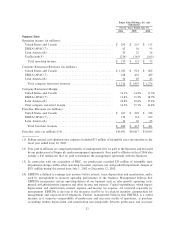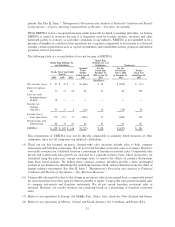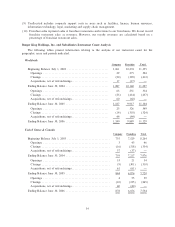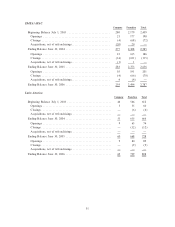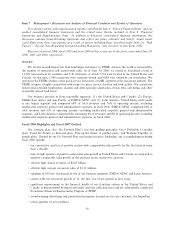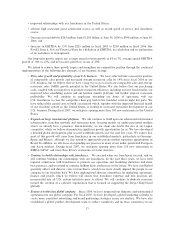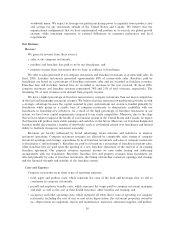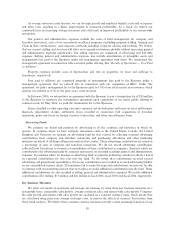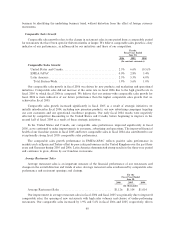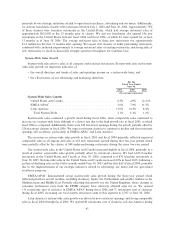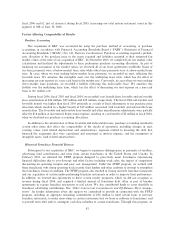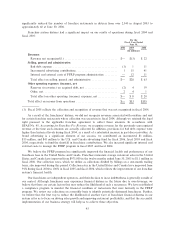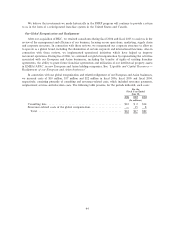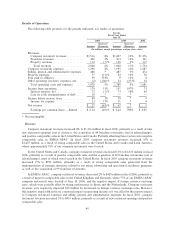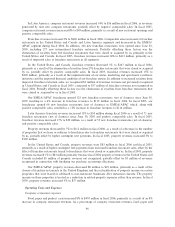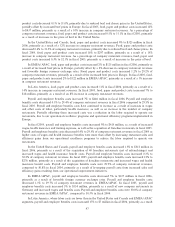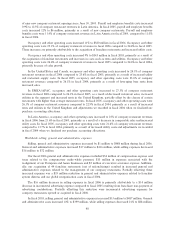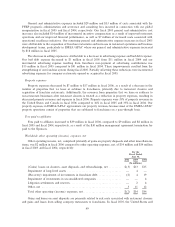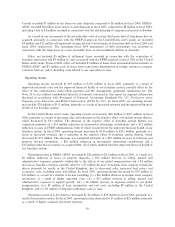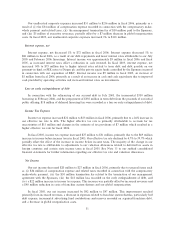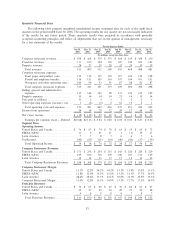Burger King 2006 Annual Report Download - page 54
Download and view the complete annual report
Please find page 54 of the 2006 Burger King annual report below. You can navigate through the pages in the report by either clicking on the pages listed below, or by using the keyword search tool below to find specific information within the annual report.fiscal 2006 and 62 (net of closures) during fiscal 2005, increasing our total system restaurant count in this
segment to 808 at June 30, 2006.
Factors Affecting Comparability of Results
Purchase Accounting
The acquisition of BKC was accounted for using the purchase method of accounting, or purchase
accounting, in accordance with Financial Accounting Standards Board (""FASB'') Statement of Financial
Accounting Standards (""SFAS'') No. 141, Business Combinations. Purchase accounting required a prelimi-
nary allocation of the purchase price to the assets acquired and liabilities assumed at their estimated fair
market values at the time of our acquisition of BKC. In December 2003, we completed our fair market value
calculations and finalized the adjustments to these preliminary purchase accounting allocations. As part of
finalizing our assessment of fair market values, we reviewed all of our lease agreements worldwide. Some of
our lease payments were at below-market lease rates while other lease payments were at above-market lease
rates. In cases where we were making below-market lease payments, we recorded an asset reflecting this
favorable lease. We amortize this intangible asset over the underlying lease term, which has the effect of
increasing our rent expense on a non-cash basis to the market rate. Conversely, in cases where we were making
above-market lease payments, we recorded a liability reflecting this unfavorable lease. We amortize this
liability over the underlying lease term, which has the effect of decreasing our rent expense on a non-cash
basis to the market rate.
During fiscal 2006, fiscal 2005 and fiscal 2004, we recorded a net benefit from favorable and unfavorable
lease amortization of $24 million, $29 million and $52 million, respectively. The fiscal 2004 unfavorable and
favorable benefit was higher than fiscal 2005 primarily as a result of final adjustments to our purchase price
allocation which resulted in a higher benefit of $19 million associated with favorable and unfavorable lease
amortization. The favorable and unfavorable lease benefit and other miscellaneous adjustments were partially
offset by $18 million of incremental depreciation expense, resulting in a net benefit of $2 million in fiscal 2004,
when we finalized our purchase accounting allocations.
In addition to the amortization of these favorable and unfavorable leases, purchase accounting resulted in
certain other items that affect the comparability of the results of operations, including changes in asset
carrying values (and related depreciation and amortization), expenses related to incurring the debt that
financed the acquisition that were capitalized and amortized as interest expense, and the recognition of
intangible assets (and related amortization).
Historical Franchisee Financial Distress
Subsequent to our acquisition of BKC, we began to experience delinquencies in payments of royalties,
advertising fund contributions and rents from certain franchisees in the United States and Canada. In
February 2003, we initiated the FFRP program designed to proactively assist franchisees experiencing
financial difficulties due to over-leverage and other factors including weak sales, the impact of competitive
discounting on operating margins and poor cost management. Under the FFRP program, we worked with
those franchisees with strong operating track records, their lenders and other creditors to attempt to strengthen
the franchisees' financial condition. The FFRP program also resulted in closing unviable franchise restaurants
and our acquisition of certain under-performing franchise restaurants in order to improve their performance.
In addition, we entered into agreements to defer certain royalty payments, which we did not recognize as
revenue during fiscal 2004, and acquired a limited amount of franchisee debt, often as part of broader
agreements to acquire franchise restaurants or real estate. We also contributed funds to cover shortfalls in
franchisee advertising contributions. See ""Other Commercial Commitments and Off-Balance Sheet Arrange-
ments'' for further information about the support we committed to provide in connection with the FFRP
program, including an aggregate remaining commitment of $36 million to fund certain loans to renovate
franchise restaurants, to make renovations to certain restaurants that we lease or sublease to franchisees, and
to provide rent relief and/or contingent cash flow subsidies to certain franchisees. Through this program, we
42


